 Website:
METREL
Website:
METREL
Catalog excerpts
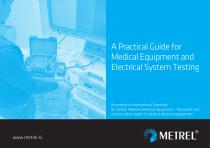
A Practical Guide for Medical Equipment and Electrical System Testing According to International Standard: IEC 62353: Medical electrical equipment – Recurrent test and test after repair of medical electrical equipment
Open the catalog to page 1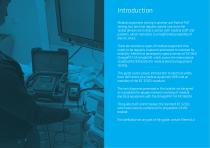
Introduction Medical equipment testing is another sub-field of PAT testing, but one that requires special care since the tested devices are in direct contact with medical staff and patients, which translates to a heightened probability of electric shock. There are numerous types of medical equipment that needs to be regularly inspected and tested to maintain its reliability. Metrel has developed a special version of MI 3360 OmegaPAT XA (model M), which covers the international standard IEC/EN 62353 for medical electrical equipment testing. This guide covers a basic introduction to...
Open the catalog to page 2
Table of contents Classification of equipment (by protection classes) 4 Typical parts of a medical equipment 5 1. Visual check (Class I, II, III) 6 2. Earth bond (Class I) 7 3. Insulation resistance (Class I, II) 4.1 Measurement of equipment leakage current 11 4.1.1 Alternative method (Equipment leakage) 11 4.1.2 Direct method (Equipment leakage) 12 4.1.3 Differential method (Equipment leakage) 13 4.2 Measurement of applied part leakage current 14 4.2.1 Alternative method (Applied part) 15 4.2.2 Direct method (Applied part) 16 4.3 Measurement of touch leakage current Sequence of testing...
Open the catalog to page 3
Classification of equipment (by protection classes) CLASSIFICATION OF EQUIPMENT (BY PROTECTION CLASSES) Class Supply cord CLASSIFICATION OF EQUIPMENT (BY PROTECTION CLASSES) Type B B-body Description Equipment with applied part(s) not isolated from power supply and enclosure. Equipment with applied part(s) isolated from power supply and enclosure. Higher protection degree. Equipment intended for cardiac applications on the patient, is isolated from power supply and enclosure. Highest protection degree. A Practical Guide for Medical Equipment and Electrical System Testing
Open the catalog to page 4
Typical parts of a medical equipment Typical parts of medical equipment that are relevant for electrical safety are shown on the picture below: Accessible conductive part A part of medical equipment other than applied part that can come in contact with the patient. Applied part An applied part is a probe or other part of equipment that necessarily comes into physical contact with the patient for the medical equipment to perform its function. Applied part of TYPE-CF provides a higher degree of protection against electric shock than parts of TYPE-B and BF. Mains part Electronic circuit that...
Open the catalog to page 5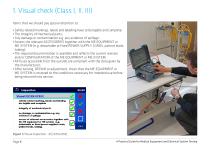
1. Visual check (Class I, II, III) Items that we should pay special attention to: • Safety related markings, labels and labelling have to be legible and complete; • The integrity of mechanical parts; • Any damage or contamination e.g. any evidence of spillage; • Assess the relevant ACCESSORIES together with the ME EQUIPMENT or ME SYSTEM (e.g. detachable or fixed POWER SUPPLY CORDS, patient leads, tubing); • The required documentation is available and reflects the current revision and/or CONFIGURATION of the ME EQUIPMENT or ME SYSTEM; • All fuses accessible from the outside are compliant...
Open the catalog to page 6
2. Earth bond (Class I) Measurements shall be performed using a measuring device able to deliver a current of at least 200 mA into 500 mΩ. The open circuit voltage shall not exceed 24 V.Low current tests (up to 1 A) are recommended, as they can disclose bad contacts. Note 1: For large cross section areas and shorter conductor lengths, higher test currents for the continuity test improve the repeatability of the test results. ME equipment or an ME system with non-detachable power supply cord - Figure 2 ME equipment or an ME system with detachable power supply cord - Figure 2 Permanently...
Open the catalog to page 7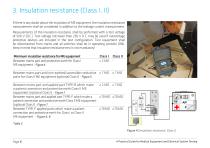
3. Insulation resistance (Class I, II) If there is any doubt about the insulation of ME equipment, the insulation resistance measurement shall be considered in addition to the leakage current measurement. Measurements of the insulation resistance shall be performed with a test voltage of 500 V (D.C.). Test voltage not lower than 250 V D.C. may be used if overvoltage protective devices are included in the test configuration. Test equipment shall be disconnected from mains and all switches shall be in operating position (ON). Keep in mind that insulation resistance test is not mandatory!...
Open the catalog to page 8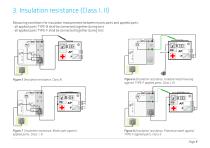
3. Insulation resistance (Class I, II) Measuring conditions for insulation measurement between mains parts and applied parts: - all applied parts TYPE-B shall be connected together during test - all applied parts TYPE-F shall be connected together during test Figure 5 (Insulation resistance, Class II) Figure 6 (Insulation resistance, Isolated metal housing against TYPE-F applied parts, Class I, II) Figure 7 (Insulation resistance, Mains part against applied parts, Class I, II) Figure 8 (Insulation resistance, Protective earth against TYPE-F applied parts, Class I)
Open the catalog to page 9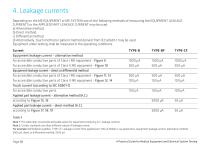
4. Leakage currents Depending on the ME EQUIPMENT or ME SYSTEM one of the following methods of measuring the EQUIPMENT LEAKAGE CURRENTS or the APPLIED PART LEAKAGE CURRENT may be used: a) Alternative method, b) Direct method, c) Differential method, d) Alternatively, touch method or patient method derived from IEC 60601-1 may be used. Equipment under testing shall be measured in the operating conditions. Current Equipment leakage current – alternative method for accessible conductive parts of Class I ME equipment - Figure 9 for accessible conductive parts of Class II ME equipment - Figure...
Open the catalog to page 10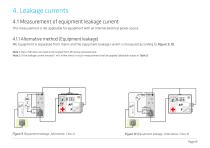
4. Leakage currents 4.1 Measurement of equipment leakage current This measurement is not applicable for equipment with an internal electrical power source. 4.1.1 Alternative method (Equipment leakage) ME Equipment is separated from mains and the equipment leakage current is measured according to Figure 9, 10. Note 1: Class I ME does not need to be isolated from PE during measurement. Note 2: If the leakage current exceeds 1 mA, either direct or touch measurement shall be applied (allowable values in Table 3). Figure 9 (Equipment leakage, Alternative, Class I) Figure 10 (Equipment leakage,...
Open the catalog to page 11All METREL catalogs and technical brochures
-
MI 3114 PV Tester
2 Pages
-
MI 3215 TeraOhmHP 15 kV
2 Pages
-
MI 3211 TeraOhmHP 10 kV
2 Pages
-
MI 3115 PV Analyser EN
2 Pages
-
MI 3132 EV Tester EN
3 Pages
-
MI 3365 25A OmegaEE XD EN
8 Pages
-
MI 3365 F OmegaEE XD EN
8 Pages
-
MI 3365 M OmegaEE XD EN
8 Pages
-
MI 3365 OmegaEE XD EN
8 Pages
-
MI 3360 OmegaGT XA guide EN
56 Pages
-
MD 9210 Mini Clamp Meter EN
2 Pages
-
Medical Facilities catalogue
64 Pages
-
Building Facilities catalogue
72 Pages
-
General catalogue 2023 EN
272 Pages
-
MI 3299 HV demo BOX
1 Pages
-
SW 1203 Metrel SDK EN
3 Pages
-
MI 3360 OmegaGT XA EN
4 Pages
-
MI 3325 MultiServicerXD EN
4 Pages
-
MI 3394 CE MultiTesterXS EN
2 Pages
-
MI 3394 CE MultiTesterXA EN
3 Pages
-
MI 6601 MediTest EN
4 Pages
-
MI 3110 EurotestIM EN
2 Pages
-
A 1722 PRCD adapter EN
2 Pages
-
A 1632 eMobility Analyser EN
2 Pages
-
A 1532 XA EVSE adapter EN
2 Pages
-
A 1532 EVSE adapter EN
2 Pages
-
MI 2093 Line Tracer EN
2 Pages
-
MI 3109 EurotestPV Lite EN
2 Pages
-
MI 3108 EurotestPV EN
2 Pages
-
MI 3125 BT EurotestCOMBO EN
2 Pages
-
MI 3125 EurotestCOMBO EN
2 Pages
-
MI 3100 SE EurotestEASI EN
2 Pages
-
MI 3102 BT EurotestXE EN
2 Pages
-
MI 3143 Euro Z 440 V EN
2 Pages
-
MI 3144 Euro Z 800 V EN
2 Pages
-
MI 3202 GigaOhm 5 kV EN
2 Pages
-
MI 3201 TeraOhm 5 kV Plus EN
2 Pages
-
MI 3311 GammaGT EN
2 Pages
-
MI 3309 BT DeltaGT EN
2 Pages
-
MI 3242 MicroOhm 2A EN
2 Pages
-
MI 3250 MicroOhm 10A EN
2 Pages
-
MI 3252 MicroOhm 100A EN
2 Pages
-
MI 3281 WR Analyser EN
2 Pages
-
MI 2891 Power Simulator EN
2 Pages
-
MI 2883 Energy Master EN
4 Pages
-
MI 2885 Master Q4 EN
4 Pages
-
MI 2884 Energy Master XA EN
4 Pages
-
MI 2892 Power Master EN
4 Pages
-
MI 2893 Power Master XT EN
4 Pages
-
MI 3205 TeraOhmXA 5kV EN
2 Pages
-
MI 3210 TeraOhm XA 10kV EN
2 Pages
-
Metrel application catalogue
28 Pages
-
MI 3155 EurotestXD EN
4 Pages
-
MI 3209 TeraOhmLT 10kV EN
2 Pages
-
MI 3102 BT EurotestXE
2 Pages
-
MD 9930 Thermal camera EN
2 Pages
-
MI 3280 DT Analyser EN
2 Pages
-
MI 3290 Earth Analyser EN
4 Pages
-
MI 3152 EurotestXC EN
2 Pages





















































































































